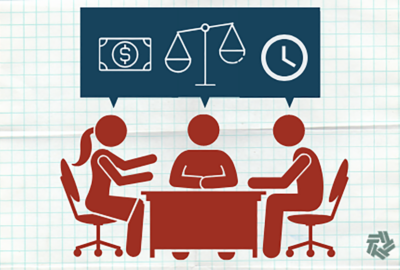What IRS office reentry plans mean for the rest of the federal workforce
As people return to the office, the IRS may be a good bellwether.
Fellow procrastinators: here’s your reminder that Tax Day is coming up.
Gather up your receipts and rummage around for your W-2, because the filing season deadline is Monday, April 18.
You’ve got a little more breathing room if you live in Maine and Massachusetts. Residents there get an extra day to file because of Patriots’ Day. Of course, you could also request an extension, and file by Oct. 17.
If you’re one of the millions of taxpayers who already filed, did you claim a home office deduction? And if so, do you think you still might next year?
Your workplace-away-from-work might not get as much use later this year, depending on which federal agency you work for.
The Biden administration expects the “vast majority” of the federal workforce will be back in the office by the end of the month.
What, specifically, that office reentry looks like changes considerably depending on where you work. It’s not an exhaustive list, but Federal News Network has details on office reentry plans at nine agencies so far.
Many of the agencies whose plans we’ve reviewed expect employees to commit to spending part of each pay period in the office.
Most of these plans say agency leadership is also planning for the “future of work,” which, much like the present-day of work or the recent-past of work, includes letting most feds continue to telework for at least part of the week.
Beyond that, the crystal ball gets a little hazy. Agencies broadly talk about how managers and supervisors should handle a “hybrid workplace,” where some staff are working from home, while others are in the office.
At a governmentwide level, the Office of Personnel Management and the General Services Administration are putting out guidance about what the future federal workplace should look like. But at this point, it’s hard to know what to expect for the average federal worker.
The IRS, however, might be a good example of what the federal workforce should expect.
The agency navigated some hurdles getting nearly all its employees the equipment and training necessary to telework at the start of the COVID-19 pandemic, but for much of its workforce, working from home has been the day-to-day for the past two years.
The IRS plans to bring bargaining unit employees back to the office in two phases, one on May 8, the other on June 25.
Chad Hooper, the executive director of the Professional Managers Association, which represents IRS managers, said the agency listened to the concerns of supervisors and employees by setting a phased reentry after the filing season deadline.
“We thought it made sense to begin this process after April 18 this year, because we didn’t want that confusion on top of the workload pressure. It’s a distraction — this is a very emotional kind of issue,” Hooper said.
Hooper said a phased reentry also helps employees get gradually reacquainted with a different work environment — especially if it’s their first time back in the office since the start of the COVID-19 pandemic.
“There are folks who haven’t been in [the office] in two years, so they’re unaware of all the things the service has done, to try to make the workplace safer — all of the HVAC improvements and distancing and all those things, which will remain in place, even after this June 25 return,” Hooper said.
However, a full return to the office may prove challenging for some employees.
“There’s still going to be a population of employees and managers and members of mine who still can’t return to normal. The IRS workforce is older than the rest of the civil service … and IRS work is often sedentary, so IRS workers sometimes struggle with chronic conditions and health issue that make them more susceptible to the deleterious effects of COVID,” Hooper said.
“The return to normal is never going to be a return to 2019. Part of that is structural, from this new union agreement, and part of it just is once you’ve given everyone a taste of what’s possible, you can’t put that genie back in the bottle,” he added.
Some lawmakers, however, argue federal employees, including IRS employees, aren’t returning to the office soon enough.
Sen. John Kennedy (R-La.) introduced the Require Employees To Uniformly Return Now (RETURN) Act in March which would require all teleworking IRS employees to return to the office until the agency has resolved a backlog of millions of unprocessed tax returns.
IRS Commissioner Chuck Rettig dismissed those concerns, however, since IRS employees have been back in the office since the summer of 2020 to handle onsite work.
“Bringing them physically into an office for two days a pay period isn’t going to process the tax return any more quickly or any more slowly,” Hooper said.
Copyright © 2024 Federal News Network. All rights reserved. This website is not intended for users located within the European Economic Area.
Jory Heckman is a reporter at Federal News Network covering U.S. Postal Service, IRS, big data and technology issues.
Follow @jheckmanWFED






